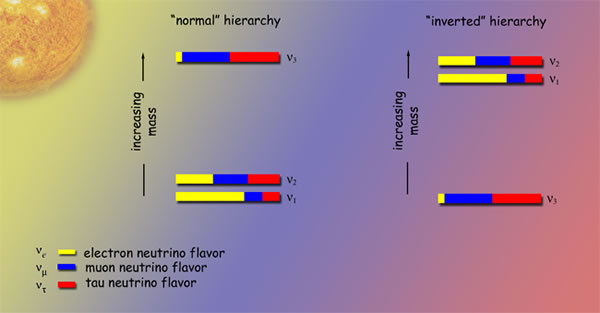"1. Interaction with matter changes the neutrino mixing and effective mass splitting in a way that depends on the mass hierarchy. Consequently, results of oscillations and flavor conversion are different for the two hierarchies.
2. Sensitivity to the mass hierarchy appears whenever the matter effect on the 1-3 mixing and mass splitting becomes substantial. This happens in supernovae in large energy range, and in the matter of the Earth.[...]
4. Multi-megaton scale under ice (water) atmospheric neutrino detectors with low energy threshold (2-3 GeV) may establish mass hierarchy with (3-10)σ confidence level in few years. [...]
7. Detection of a neutrino burst from relatively close supernovae (which may occur any time) may resolve the issue of neutrino mass hierarchy."
Alexey Smirnov, "Neutrino mass hierarchy and matter effects", proceedings of Neutrino Telescopes XV, 2014.
A little background for those of you who do not know what this is about, but are curious enough to have browsed until here: We are talking of neutrinos, the elusive, almost massless particles that are emitted in nuclear fusion reactions by the cores of stars, or by radioactive decays. Neutrinos exist in three flavors - the electron, the muon, and the tauon kind. They have different masses, and they oscillate between one flavor and the others as they propagate in space. When they cross matter, they very rarely interact; but even when they do not, their oscillation properties vary, depending on matter density as well as on the hierarchy of masses -e.g. whether the tauon neutrino is the heaviest or whether instead it is the lightest of the three.

In the above picture (credit: LBL) the three neutrino mass states ν1, ν2, ν3 are represented by bars with three colors. Each colour represent a flavor: the three flavor mix in each mass state, as suggested by the color of the bars. The inverted hierarchy has the v3 state laying at lower mass than the other two.
Determining the true hierarchy of masses of the three neutrinos is an important challenging problem nowadays. We might need to construct even larger neutrino detectors than the ones already existing to find a solution to that problem, or we might get lucky... With a little help from our friends, the close supernovae. They produced the heavy elements of which our bodies are composed, some billions of years ago, and they might help us further today, saving us the digging of new underground facilities!



Comments